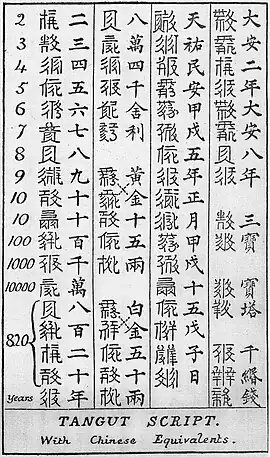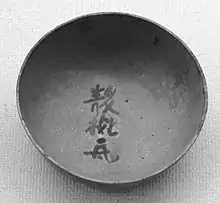| Part of a series on |
| Numeral systems |
|---|
| List of numeral systems |

Tangut numerals are words and characters used to denote numbers in the Tangut language during the Western Xia regime (1038–1227) and during the subsequent Yuan dynasty (1271–1368).
Tangut numerals are written in the same format as Chinese numerals. There is an ordinary set of digits that is used for writing numbers within Tangut text (for example, chapter numbers and dates) in manuscripts and printed books, as well as for engraving on monumental inscriptions on stone. There are also two additional sets of number characters used for special purposes. Page numbers in printed books dating from the Western Xia period and the Yuan dynasty are often written using Chinese numerals.
The latest surviving example of Tangut numerals occur on the Tangut dharani pillars which were erected in Baoding on the 10th month of the 15th year of the Hongzhi era of the Ming dynasty, which corresponds to 1502.[1]
Cardinal numbers
The characters used to write ordinary cardinal numbers are listed below. There are two different words for "ten": 𗰗 *gha is the normal word, but 𗰭 *sha is sometimes used, especially for the number of days in dates, e.g. 𗰗𗼑𗰭𗾞 (gha lhi sha ny) "10th day of the 10th month".
| Number | Character | Reading |
|---|---|---|
| 1 | 𘈩 | *lew |
| 2 | 𗍫 | *ny / njɨ̱ |
| 3 | 𘕕 | *so / sọ |
| 4 | 𗥃 | *lyr / ljɨr |
| 5 | 𗏁 | *ngwy / ŋwǝ |
| 6 | 𗤁 | *chhiw / tśhjiw |
| 7 | 𗒹 | *sha / śjạ |
| 8 | 𘉋 | *ar / ˑjar |
| 9 | 𗢭 | *gy / gjɨ |
| 10 | 𗰗 | *gha / ɣạ |
| 10 | 𗰭 | *sha |
| 100 | 𘊝 | *ir / ˑjir |
| 1,000 | 𗡞 | *tu / tụ |
| 10,000 | 𗕑 | *khy / khjɨ |
| 100,000,000 | 𗦲 | *rir / rjir |
Multiple-digit numbers are constructed using a similar method to that for Chinese and Japanese numerals.
| Number | Structure | Transliteration | Characters |
|---|---|---|---|
| 14 | [10] [4] | gha lyr | 𗰗𗥃 |
| 60 | [6] [10] | chhiw gha | 𗤁𗰗 |
| 105 | [1] [100] [5] | lew ir ngwy | 𘈩𘊝𗏁 |
| 518 | [5] [100] [10] [8] | ngwy ir gha ar | 𗏁𘊝𗰗𘉋 |
| 2,362 | [2] [1,000] [3] [100] [6] [10] [2] | ny tu so ir chhiw gha ny | 𗍫𗡞𘕕𘊝𗤁𗰗𗍫 |
Ordinal numbers
Ordinal numbers are formed by adding the suffix 𗡪 *tsew to the cardinal number, for example 𘕕𗡪 (so tsew) "third" and 𗍫𗰗𗡪 (ny gha tsew) "twentieth". The word 𗨁𗡪 (phu tsew) may be used for "first", although 𘈩𗡪 (lew tsew) is also found.
Fractions

The character 𗸕 *khwy is used for one half. For more complex fractions, the formula "n [parts] out of d parts" is used, where n is the numerator and d is the denominator, and the denominator is specified first. This corresponds to the structure for fractions in Chinese, for example Tangut 𘕕𘊲𘂤𘈩 (so pha kha lew) "one third" corresponds to Chinese 三分之一 (sān fēn zhī yī) "one third".
| Number | Structure | Transliteration | Characters |
|---|---|---|---|
| 3½ taels | [3] [tael] [½] | so lu khwy | 𘕕𗍬𗸕 |
| two-thirds | [3] [parts] [among which] [2] [parts] | so pha kha ny pha | 𘕕𘊲𘂤𗍫𘊲 |
| 1/1000 | [1000] [parts] [among which] [1] | tu pha kha lew | 𗡞𘊲𘂤𘈩 |
Special numbers
In addition to the normal set of cardinal numbers, there is an additional set of characters used for the numbers 2 through 7 in some circumstances. These numbers are only used in a few certain words, as well as in special month names that are used in a Tangut ode entitled Poem on Pleasure of Every Month.[2] Ksenia Kepping considers this and other odes in the same collection (dated 1185) to be written in a special ritual language, using vocabulary which is not normally used in the common Tangut language.[3]
There is also a special set of filiation characters for the numbers 2 through 8 which are used exclusively to indicate the relative seniority of sons, where the number is followed by the word 𗷸 *ew "son". The numbers from 2 to 7 are phonetically identical (2, 4, 6, 7) or phonetically very close (3, 5) to the corresponding ritual numbers used in the Poem on Pleasure of Every Month, but the character for 8 is phonetically identical to the normal character for 8.
Unlike the ordinary Tangut numbers, which are closely cognate to the numbers used in other Tibeto-Burman languages such as Tibetan and Nuosu, the ritual and filiation numbers do not appear to be related to numbers in any other language. Moreover, the characters for 4 and 7 are homophones in both the ritual and filiation series, which is implausible for a spoken language.
| Number | Ritual character | Reading | Filiation character | Reading |
|---|---|---|---|---|
| 2 | 𘂚 | *lo | 𘂈 | *lo |
| 3 | 𗛰 | *rer | 𗬏 | *len |
| 4 | 𗝝 | *ngwyr | 𗓟 | *ngwyr |
| 5 | 𗉨 | *chyr | 𘗤 | *tsyr |
| 6 | 𘍼 | *vi | 𘊚 | *vi |
| 7 | 𗘎 | *ngwyr | 𗸨 | *ngwyr |
| 8 | 𗸪 | *ar |
The ritual numbers are used in the following words, which are all related to Buddhism or astrology:
- 𗋾𘂚 (zhu lo) "two fish" (i.e. pisces)
- 𗛰𗔇 (rer u) "three storehouses" (i.e. the tripiṭaka)
- 𗝝𗖟 (ngwyr ka) "four stringed-instrument" (i.e. the pipa)
- 𗉨𗔕𘑗 (chyr nir ngyr) "Five Platforms Mountain" (i.e. the Western Xia equivalent of the sacred Mount Wutai, which was located in the Helan Mountains)
- 𗘎𗤪 (ngwyr ngewr) "seven sounds" (i.e. seven claps of thunder or bursts of music)
Dates
Tangut numbers are used to denote the year, month and day in date expressions.
A number followed by the character 𗤒 *kew "year" indicates the year of the specified era, for example 𘀗𘑨𗰗𗤁𗤒 (tshwu wu gha chhiw kew) means the 16th year of the Qianyou era (i.e. 1185).
Lunar months are designated as a number followed by 𗼑 *lhi "moon, month", except that there are special words for the first and last month. An intercalary month is indicated by putting the character 𘒹 *lhu in front of the month name, for example 𘒹𗎊𗼑 (lhu rer lhi) "intercalary 12th month). There are also special month names used in the ritual language of the Poem on Pleasure of Every Month.
| Month | Common name | Reading | Ritual name | Reading | Meaning |
|---|---|---|---|---|---|
| 1st | 𗩭𗼑 | chon lhi | 𗤒𗆧𘘞𗳝 | kew siw ka o | "new year month" |
| 2nd | 𗍫𗼑 | ny lhi | 𘙇𘂚𘘞𗳝 | ryr lo ka o | "second month" |
| 3rd | 𘕕𗼑 | so lhi | 𗛰𘕻𘘞𗳝 | rer gu ka o | "third month" |
| 4th | 𗥃𗼑 | lyr lhi | 𗲛𗝝𘘞𗳝 | kwe ngwyr ka o | "fourth month" |
| 5th | 𗏁𗼑 | ngwy lhi | 𗉨𗘝𘘞𗳝 | chyr lu ka o | "fifth month" |
| 6th | 𗤁𗼑 | chhiw lhi | 𘀐𘍼𘘞𗳝 | zhiw vi ka o | "sixth month" |
| 7th | 𗒹𗼑 | sha lhi | 𗘎𗘋𘘞𗳝 | ngwyr ka ka o | "seventh month" |
| 8th | 𘉋𗼑 | ar lhi | 𗍫𗥃𘘞𗳝 | ny lyr ka o | "two four month" |
| 9th | 𗢭𗼑 | gy lhi | 𗥃𗏁𘘞𗳝 | lyr ngwy ka o | "four five month" |
| 10th | 𗰗𗼑 | gha lhi | 𗍫𗏁𘘞𗳝 | ny ngwy ka o | "two five month" |
| 11th | 𗰗𘈩𗼑 | gha lew lhi | 𗏁𗤁𘘞𗳝 | ngwy chhiw ka o | "five six month" |
| 12th | 𗎊𗼑 | rer lhi | 𗌽𗎓𘘞𗳝 | dy kewr ka o | "cold month" |
A number followed by the character 𗾞 *ny "day" indicates the day of the month, for example 𗒹𗼑𗰭𗢭𗾞 (sha lhi sha gy ny) "19th day of the 7th month".
See also
Footnotes
- ↑ Shi & Bai 1977, pp. 146–147
- ↑ Nishida 1986, pp. 1–116
- ↑ Kepping 1996, pp. 26–28
References
- Kepping, Ksenia (1996), "Tangut Ritual Language" (PDF), 29th International conference on Sino-Tibetan languages and linguistics, Leiden, 10–13 October 1996, pp. 24–28
- Nishida, Tatsuo (1986), "Seikago 'tsukizuki rakushi' no kenkyū 西夏語『月々楽詩』の研究" [Study of the Tangut language 'Poem on Pleasure of Every Month'] (PDF), Kyoto Daigaku Bungakubu Kiyō 京都大学文学部紀要, 25: 1–116
- Shi, Jinbo; Bai, Bin (1977), "Mingdai Xixiawen jingjuan he shichuang chutan (明代西夏文經卷和石幢初探)" [Preliminary investigations into Ming dynasty Tangut sutras and stone dhanari columns revisited], Kaogu Xuebao (1): 143–164